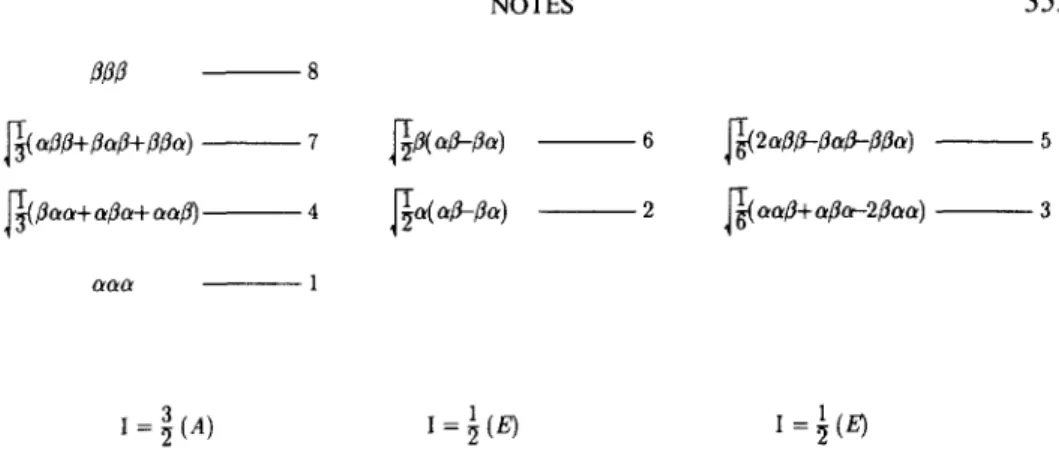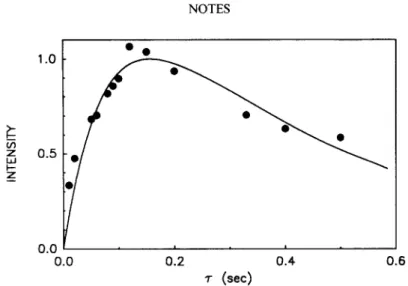Relaxation of Longitudinal Three-Spin Order
PEI-LEIN W A N G
Department of Nature Science, Municipal Teachers College, Taipei, Taiwan, Republic qf China
AND
LIAN-PIN HWANG*
Department of Chemistry, National Taiwan University, a n d Institute ofAtomic a n d Molecular Science, Academia Sinica, Taipei, Taiwan, Republic of China
Received October 25, 1988; revised January 9. 1 9 8 9
Nuclear magnetic resonance relaxation studies are a n important tool for the study of m o lecular dynamics in liquids. Recent advances in both NMR theory a n d experi- mental techniques have substantially increased the level of information of m o lecular dynamics in liquids. T h e development of m u ltiple-quantum relaxation (MQR) ( I ) has paved new ways to study the m o lecular dynamics in liquids. T h e advent of the M Q R experiment opens the possibility of selecting the appropriate spin interaction which generates only a certain order of MQR. M u ltiple-quantum relaxation via trans- verse relaxation for degenerate spin systems has b e e n applied to the study of slow m o lecular motion in macromolecules a n d m o lecular aggregates (2,3). For longitudi- nal relaxation, several authors have demonstrated that dipole-dipole cross-relaxation m a y lead to the conversion of Z e e m a n order into three-spin order (4). Particularly in the work of Bijhlen et al., a so-called “pseudo-two-dimensional” spectrum has b e e n obtained to demonstrate the effect of dipole-dipole cross-relaxation (4). In the present work, we report the result of a study which utilizes the one-dimensional ana- log of the triple-quantum 2D experiment via longitudinal relaxation to determine the relaxation behavior of three-spin order for the methyl protons in the deoxycholate (DOC) m icelle system.
T h e pulse sequence used for measuring the relaxation of three-spin order is basi- cally a m u ltiple-quantum-filter pulse sequence as depicted in F ig. 1. T h e phases of the receiver a n d of the various pulses in the phase-cycling scheme were reported ear- lier (3, 5- 7) for a triple-quantum filter. In order to eliminate the transverse contribu-
* To whom correspondence should b e addressed.
3 5 1 0022-2364189 $3.00
Copyright 0 1989 by Academic Press, Inc. All rights ofreproduction m any form resewed.
tion of triple-quantum coherence due to the imperfection of the r pulse, 180” phase alternations in the inversion pulse are added in the phase-cycling scheme.
The description of the relaxation processes may be given in terms of the evolution of the density matrix in accordance with these pulse sequences. Since there is no two- spin order for an A3 spin system we will limit our treatment to the proton relaxation of three-spin order in the methyl group. The spin-lattice interaction Hamiltonian of this system is defined by
z(t) = c %j c (-1 YzYi,j>Y7(4i/) + CI Yi c (-lYT(wG”(~, t),
[II
i<J ?,I i m
where we follow the notations defined in Ref. (2) such that tij E (G/ 5 )rirj h / ri, TF ( i , j) is a spin tensor operator of rank s , Y; “( 4,) is a spherical harmonic function of rank 2, B;“( i, 1) is a lattice random field interaction operator, yi is the gyromag- netic ratio of species i of the methyl protons, and Tij is the distance between protons i and j in the methyl group. The first term is due to the intramolecular dipolar interac- tions with s = 2 among the three protons of the methyl group and the second term is due to other unspecified interactions which are approximated by the isotropic ran-
domfieldmodelwiths= l;i.e., IBy(i,t)1’= IBt(i,t)l*= IB;‘(i,t)(*.
In the periods in which the three-spin order evolves, and in the final detection period, the Redfield theory (8) is utilized to account for the relaxation processes for the methyl protons. The evolution of the density matrix p follows the equation of motion
4
z= RP, [21
where R is the Redfield relaxation matrix which may be constructed for longitudinal relaxation in accordance with the interaction Hamiltonian defined in Eq. [ 11. The density matrix p is defined as
i = bll, P44, P77, P88, P22, P66r P33, PSSI. [31
The matrix elements are labeled according to the spin energy levels as shown in Fig. 2.
To describe the interferences between the various modes of motion, which include internal rotation and wobbling motion of the methyl group and the overall reorienta- tion of the micellar aggregate or the macromolecule, the cone model of Brainard and Szabo ( 9) is used to facilitate the calculation of the auto- and cross-correlation spec-
I = ;(A) I=;(E) I=;@?
FIG. 2. Energy level diagram and basis functions for the Ax spin system. The symmetry of the basis functions is indicated in parentheses.
tral densities. In this model, the dynamics of the molecular aggregates or the macro- molecules are described by an isotropic slow reorientation of the whole molecule (or aggregate) and the fast internal motions for the methyl groups of interest. With the consideration of the auto- and cross-correlation of dipolar relaxations (IO) among the three protons, the auto- and cross-spectral density functions used in the calculation of the relaxation matrix elements are given by
3 S2(6D+4Di)
+ 4 cos(n+r) [((jo + doi)2 + @2]
+~cos~n,,) (1 -S2)[6~+4Q+2Qv/(l
es211
4 ’ [60+40i+20,/(1-S2)]2+w2
where cos( QOkr) = 1 for rij = rk/ and cos( fi#,) = - f for rii P rk/ to account for the auto- and cross-relaxations, respectively. It is assumed that the overall reorientational motion of the m icelle has a correlation tim e 7O = 1 / 6 D, the internal rotation of the methyl group has a correlation tim e Ti = l/44, and the wobbling motion of the methyl C, axis has a correlation tim e T, = 1 / 6 0,. The wobbling motion is assumed to be within a cone of 0 with a constant distribution and an order parameter S which is defined by (9)
s= cosB(l + cos8)/2. 151
For the treatment of isotropic random field interaction, the corresponding spectral density function is defined by
and I( I1 ). Equation [ 71 shows that the nonuniform relaxations of the longitudinal elements p, , (or ps8) and p44 (or p77) give rise to the creation of multiple-quantum coherence.
The evolution time A of the multiple-quantum coherence should be set much shorter than the transverse relaxation time so that relaxation may be neglected during this interval. In the present work, a A of 20 Z.LS was used. After the application of the monitor pulse, the signals of various order of multiple-quantum coherences are converted into single-quantum coherence for observation. The selective observation of a certain order of multiple-quantum coherence can be achieved by the appropriate phase-cycling schemes reported (3,5- 7) previously. The elements of the density ma- trix p(t) for observation of triple-quantum coherence become
p14(7 + A+) = - 8 (cos3<- COS <)PI8(7 + A-)
,047(7 + A+) = ;(COS 3r-- COS {)P,8(T + A-)
,078( 7 + A+) = - COS 3{- COS {)p,8(7 + A-).
The pulse angle of the monitoring pulse {is set to the magic angle ( 54.74”) in order to optimize the signal. If [ = n/2 is used, no signal due to triple-quantum coherence can be observed.
The magnetization M, observed during the detection period t > T + A is then evaluated by
M, = rti Tr(p1,) cx (fi P14 + 2P47 + 678 + fiP; + 2P& + 6,;). [91
During the acquisition period, nonuniform relaxation of the transverse elements p14, p47, and p78 gives rise to the creation of the finite spectral density arising from the
cross-relaxation.
The measurements of triple-quantum coherence have been obtained for the methyl groups of DOC in a 75 m M D20 micellar solution at 30 1 K with a Bruker AM-300 spectrometer operating at 7.05 T. Since the signal of methyl 18 is better resolved than those of the methyl 19 and 2 1 groups, we will focus our attention on the results for this methyl group. The experimental intensity profile of the methyl proton relaxation of three-spin order is shown in Fig. 3.
In a previous study, we determined a set of parameters, as listed in Table 1, which were obtained not only by fitting the proton MQR T, and T2 but also by fitting multi-
1.0
0.5
0.0
0.2 0.4 0.6
7 (set)
FIG. 3. Proton triple-quantum peak intensity as a function of evolution time for methyl 18 of the 75 m M DOC micelle in a 0. I M Na2C03, pD 9.0, aqueous solution at 30 1 K.
field carbon- 13 T, , NOE, and differential line-broadening effects in the proton-cou- pled 13C spectrum. The theoretical curve is also shown in Fig. 3 for comparison. In the intensity profile for longitudinal relaxation, the calculated maximum intensity appears around 150 ms, while for transverse triple-quantum relaxation it was found around 35 ms (3). As it was pointed out previously (2, 3) for transverse double- and triple-quantum relaxation, the nonuniform relaxation of the transverse elements due to dipolar cross-relaxation in the quartet levels results in the creation of multiple- quantum coherence. However, in the presence of dipole-dipole cross-interaction, the dipolar coupling between quartet levels and doublet levels plays the key roles in the creation of nonuniform relaxations of longitudinal elements. Since the m icellar sys- tem satisfies the motional conditions wn7, > 1, wn7i 6 1, and wn7, + 1, where on is the Larmor frequency of the N M R experiment, the relaxation profile of three-spin order is found to be rather insensitive to the variation of 7,. Increasing magnitude of 7i or 7, results in a shift of maximum intensity to a shorter tim e and an early decay
profile, Similar trends were also observed with the increase of 1 j(o) 1 and, more im- portant, the magnitude of these three-spin order signals in general increases with the value of order parameter. Without the dipole-dipole cross terms the calculated signal
TABLE I
Dynamic and Order Parameters Utilized in the Calculation of Three-Spin Order Relaxation in Accordance
with the Cone Model
s 7. (ns) 7, (ps) Tw (ps) AOY i(o)
0.64 4.5 7.6 22.1 15.5 -1.00
” Evolution of longitudinal three-spin order is not affected by the j(0) term.
REFERENCES 1. A. WOKAUN AND R. R. ERNST, Mol. Phys. 36,3 17 ( 1978).
2. L. E. KAY AND J. H. PRESTEGARD, J. Am. Chem. Sot. 109,3829 ( 1987).
3. T. C. WONG, P. L. WANG, D. M. DUH, AND L. P. HWANG, J. Phys. Chem. 93, 1295 ( 1989).
4. M. BGHLEN, S. WIMPERIS, AND G. BODENHAUSEN, J. Mugn. Reson. 77,589 ( 1988). 5. A. WOKAUN AND R. R. ERNST, Chem. Phys. Lett. 52,407 ( 1977).
6. U. PIANTINI, 0. W. S@RENSEN, AND R. R. ERNST, J. Am. Chem. Sot. 104,680O ( 1982). 7. L. BRAUNSCHWEILER, G. BODENHAUSEN, AND R. R. ERNST, Mol. Phys. 48,533 ( 1983).
8. A. G. REDFIELD, in “Advances in Magnetic Resonance” (J. S. Waugh, Ed.), Vol. 1, p. 1, Academic Press, New York, 1965.
9. J. R. BRAINARD AND A. SZABO, Biochemistry 20,46 18 ( 198 1).
10. J. R. HUBBARD, J. Chem. Phys. 52,563 ( 1970).
11. L. G. WERBELOW AND D. M. GRANT, in “Advances in Magnetic Resonance” (J. S. Waugh, Ed.), Vol. 9, p. 189, Academic Press, New York, 1977.

